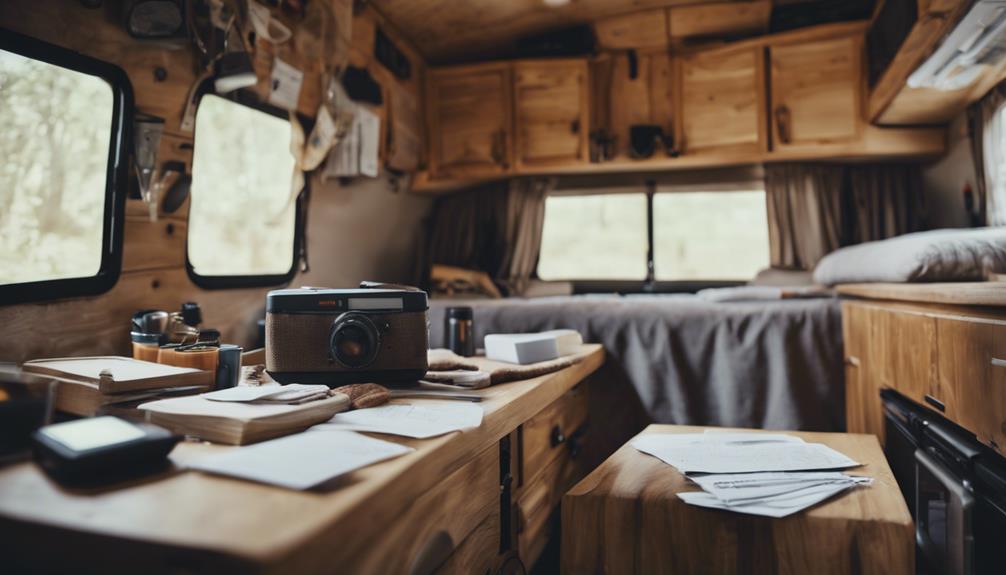When you're converting a camper, choosing the right wood is key to keeping it lightweight and durable. Paulownia wood stands out for its exceptional lightness and natural insulation properties, boosting fuel efficiency. Plywood is also a solid choice due to its good strength-to-weight ratio and moisture resistance, especially in higher grades. While heavier options like birch plywood offer strength, they can add unnecessary weight. Staying informed about advanced wood treatments can also enhance durability. If you want insights on selecting the best wood types and effective maintenance tips, you might want to explore more on this topic.
Introduction
When converting a camper, choosing the right wood can make all the difference in ensuring your vehicle is both lightweight and durable. The type of wood you select impacts not just the structural integrity but also the overall comfort during your travels.
Lightweight woods like Paulownia are excellent choices, weighing only 270 kg/m³, which is considerably lighter than options like pine or birch. This weight reduction can enhance your camper's fuel efficiency and maneuverability, making your adventures more enjoyable.
Plywood is another popular option for camper interiors. It's made from high-quality veneers that offer strength and water resistance. Plus, plywood is generally easier to work with than solid wood, making your conversion process smoother.
It's essential to take into account the wood's resistance to humidity, as this affects the longevity of your camper's interior. The right wood not only contributes to durability but also enhances insulation properties, providing superior thermal and acoustic benefits.
Background Information
When it comes to camper conversions, understanding the evolution of lightweight materials is key to making informed choices.
Innovations in wood treatments have also transformed how we use different types of wood, enhancing their performance and durability.
You'll want to contemplate these advancements to optimize your camper's design and efficiency.
Evolution of Lightweight Materials
The evolution of lightweight materials has transformed camper conversions, enhancing fuel efficiency and performance while addressing weight limitations that affect maneuverability and economy.
You'll find that traditional materials like plywood and MDF are now complemented by innovative options, such as paulownia wood. Weighing in at just 270 kg/m³, paulownia wood stands out as one of the lightest woods available, making it a prime choice for your camper conversion.
Additionally, advances in engineered woods, like laminated veneer lumber and composite panels, provide the strength you need without greatly increasing weight. This means you can design more efficient mobile living spaces without sacrificing durability.
The rise of synthetic materials and advanced composites has further improved the lightweight trend, offering moisture resistance and enhanced durability compared to conventional wood products.
Moreover, sustainable practices have played an essential role in the selection of these lightweight materials. Fast-growing species like paulownia not only offer a superior strength-to-weight ratio but also have a reduced environmental impact, promoting eco-friendly living solutions in your camper conversion journey.
Embracing these materials can lead to a more efficient and sustainable travel experience.
Innovations in Wood Treatments
As you explore lightweight materials for your camper conversion, it's equally important to contemplate the latest innovations in wood treatments that enhance durability and performance.
Advanced methods like heat treatment are gaining traction, enhancing wood's resistance to pests and decay without relying on chemicals. This is essential for maintaining a safe environment in your camper.
Pressure treating wood with preservatives is another effective option, increasing durability and protecting against moisture, which is especially beneficial in varying climates.
Eco-friendly coatings, such as water-based finishes, provide necessary protection while ensuring low VOC emissions, making them ideal for indoor air quality.
Additionally, nanotechnology is revolutionizing wood treatments by creating hydrophobic surfaces that repel water, greatly reducing swelling and warping in humid conditions.
Thermally modified wood is also worth considering; it offers remarkable dimensional stability and decay resistance, making it an attractive choice for camper van applications.
Emerging Wood Treatment Technologies

When you're considering wood for your camper conversion, it's essential to explore the latest treatment technologies that enhance durability and performance.
Sustainable sourcing practices guarantee that the wood you choose isn't only effective but also environmentally friendly.
Advanced moisture resistance techniques can considerably extend the lifespan of your materials, making your camper a more reliable home on wheels.
Sustainable Sourcing Practices
Sustainable sourcing practices in wood selection prioritize certified forests and innovative treatment technologies to guarantee eco-friendly choices for your camper conversion. By opting for wood from certified sources like FSC or PEFC, you ascertain that the materials you use are responsibly harvested, promoting forest health and biodiversity.
Emerging wood treatment technologies enhance the durability of your wood without relying on harmful chemicals. Techniques like thermal modification and acetylation improve moisture resistance, making your camper conversion more resilient. Additionally, innovative solutions such as bio-based coatings and nanotechnology further extend the lifespan of wood while maintaining environmental integrity.
When considering your options, look for rapidly renewable wood species like paulownia. These species grow faster than traditional hardwoods, making them a sustainable choice that helps reduce deforestation. Furthermore, focus on suppliers that employ energy-efficient kilns and waste recovery systems, as these practices minimize carbon footprints during processing.
Advanced Moisture Resistance Techniques
Choosing the right wood treatment technologies can greatly enhance your camper's durability and performance against moisture.
One effective method is thermal modification, which alters the wood's cellular structure, considerably improving moisture resistance. This process reduces the wood's ability to absorb water, minimizing swelling and damage.
Another advanced technique is acetylation, where hydroxyl groups in the wood are replaced with acetyl groups. This chemical modification boosts dimensional stability and decay resistance, especially in humid environments.
You might also consider coatings with advanced polymer technologies like polyurethane and epoxy. These coatings form a robust barrier against moisture, effectively extending the lifespan of your camper's wood.
Additionally, incorporating water-repellent treatments infused with silicone-based compounds can repel water while preserving the wood's natural appearance and breathability.
Finally, innovations in biocidal treatments can help prevent mold and mildew growth, enhancing moisture resistance and maintaining a healthy interior environment in your camper.
Wood Durability Comparisons
When choosing the best wood for your camper conversion, it's essential to understand the strengths and weaknesses of different options.
You'll want to take into account insights from industry specialists and review how each wood type performs under various conditions.
This knowledge will help you make an informed decision that balances durability and weight for your camper needs.
Strengths and Weaknesses
Understanding the strengths and weaknesses of different wood types is essential for ensuring the durability and longevity of your camper conversion.
When it comes to lightweight options, paulownia wood stands out as the lightest choice, weighing only 270 kg/m³. This makes it ideal for reducing overall vehicle weight while still maintaining strength.
On the other hand, birch plywood provides a good balance of strength and humidity resistance, but it's heavier than paulownia, which can affect your camper's weight efficiency.
If you're looking for cost-effective materials, OSB and chipboard may seem appealing, but they weigh considerably more (650-740 kg/m³) and have poor moisture resistance, making them a less suitable choice for mobile environments.
Fiberboard, while easy to paint and somewhat versatile, falls short in durability against moisture with a weight of 675-700 kg/m³.
Ultimately, the wood you select will impact both the structural integrity and long-term performance of your furniture. Lighter woods like paulownia not only provide ecological benefits but also enhance fuel efficiency, making them a smart choice for your camper conversion.
Industry Specialist Insights
Analyzing wood durability reveals how different types perform under the unique stresses of camper living, with specialists often highlighting paulownia's lightweight yet robust nature as a standout option.
Weighing only 270 kg/m³, paulownia is considerably lighter than traditional woods like pine and birch, making it perfect for weight-sensitive camper conversions. When you consider plywood made from paulownia veneers, you're looking at an excellent strength-to-weight ratio that guarantees durability while minimizing the overall load on your camper.
This lightweight property of paulownia enhances fuel efficiency and maneuverability in your van. Unlike OSB and chipboard, which are much heavier, paulownia contributes to improved performance and handling.
What's more, paulownia wood exhibits no knots, which boosts material efficiency and structural integrity—essential for maintaining durability in a mobile living environment.
The ecological benefits of using this fast-growing, renewable resource not only support sustainable sourcing but also help reduce your carbon footprint. So, when you're planning your camper conversion, opting for paulownia can be a smart choice for both durability and sustainability.
Wood Type Performance Review
Choosing the right wood for your camper conversion is vital, as different types offer varying levels of durability and weight, impacting your overall experience on the road.
If you're looking for lightweight options, paulownia wood stands out with a mere weight of 270 kg/m³, considerably lighter than pine (520 kg/m³) and birch (650 kg/m³). This weight reduction is essential for improving fuel efficiency in your camper.
Plywood is another popular choice, made up of multiple layers providing strength and good moisture resistance. However, its weight can fluctuate depending on the type of wood used, so be mindful when selecting it.
While economical, OSB and chipboard weigh in at around 650 kg/m³ and 720-740 kg/m³, making them less ideal for your camper due to their heft.
When considering durability, hardwoods generally resist wear better than softwoods. Yet, with proper treatment, lighter woods like paulownia can also perform admirably.
Opting for higher-grade plywood will enhance moisture resistance, making it a smart choice for areas in your camper that see heavy use.
Essential Maintenance Guidelines

To keep your camper's wood features in top shape, you need a solid maintenance routine.
You'll want to regularly check for wear and tear, clean surfaces, and inspect joints to guarantee everything stays secure.
Maintenance Routine Overview
Regular maintenance of wooden surfaces in your camper is essential for preventing damage and guaranteeing longevity.
Start by regularly inspecting all wooden areas for signs of wear, particularly in spots exposed to moisture. Catching issues early can help you avoid costly repairs. For cleaning, use a mild soap and water solution; steer clear of harsh chemicals that could harm the wood's finish.
Every 1-2 years, make it a point to reapply protective finishes or sealants. This will help maintain moisture resistance and extend the wood's life. Additionally, pay attention to any loose joints or connections in cabinetry and furniture. Tighten screws or use wood glue as needed to keep everything secure.
It's also important to monitor humidity levels inside your camper van. Excess moisture can lead to warping or mold growth on wooden surfaces, so consider using a dehumidifier if necessary.
Following this maintenance routine overview will guarantee your camper remains in top shape, allowing you to enjoy your adventures worry-free.
Routine Care Techniques
Routine care for wood surfaces in your camper guarantees longevity and enhances your overall experience while traveling. Start by regularly inspecting the wood for signs of wear, moisture damage, or pest infestations to maintain its integrity.
To keep your surfaces clean, use a damp cloth and mild soap to remove dirt and grime, steering clear of harsh chemicals that can harm the finishes.
Every 6 to 12 months, apply a protective sealant or wood conditioner, especially in humid areas, to boost durability and moisture resistance. If you notice any rough spots or scratches, sand them down with fine-grit sandpaper to maintain a smooth finish and prevent splintering. This secures both safety and comfort during your adventures.
Additionally, store your camper in a shaded, dry area when not in use. This protects your wood, including Edge Glued surfaces, from UV damage and excessive moisture.
Implementing these routine care techniques won't only extend the life of your camper's wood surfaces but also provide a more enjoyable traveling experience. Remember, consistent maintenance is key to preserving your camper's beauty and functionality.
What are the Most Durable and Lightweight Wood Options for a VW Crafter Camper Conversion?
When considering the most durable and lightweight wood options for a spacious VW camper conversion, popular choices include birch plywood, bamboo, and cedar. These woods are known for their strength and low density, making them perfect for creating a sturdy and efficient interior for your VW Crafter camper conversion.
Conclusion
Choosing the right wood for your camper conversion can greatly enhance both the functionality and aesthetic appeal of your mobile living space. If you're looking for a good option, consider using paulownia wood. Weighing just 270 kg/m³, it considerably reduces your vehicle's overall weight, improving fuel efficiency on your travels.
Paulownia's premium edge-glued panels, available in thicknesses from 12mm to 30mm, provide both structural integrity and a lightweight profile. This wood's enchanting grain patterns and warm tones add a touch of elegance to your camper's interior, making it an increasingly popular choice among van lifers.
Moreover, the excellent natural insulation properties of paulownia contribute to a comfortable living environment, regardless of the weather outside. By choosing sustainably sourced paulownia, certified by organizations like FSC/PEFC, you're not only ensuring durability and style but also supporting eco-friendly practices that reduce your carbon footprint.
Frequently Asked Questions
What Wood to Use for Camper Conversion?
When you're choosing wood for camper conversion, consider lightweight options like paulownia or plywood. They're durable and won't weigh you down. Avoid heavier woods and materials that could compromise your fuel efficiency and maneuverability.
What Is the Best Wood for a Camper Bed?
When considering the best wood for a camper bed, you'll want something lightweight yet durable. Paulownia is an excellent option, offering a great strength-to-weight ratio and natural insulation, making your sleeping space cozy and efficient.
What Is the Best Lightweight Material for Van Conversion?
When choosing a lightweight material for your van conversion, consider paulownia wood. It's incredibly light yet strong, offering excellent insulation and sustainability. You'll appreciate its versatility for furniture and cabinetry while keeping your vehicle's weight down.
What Is the Best Material for Campervan Cabinets?
When choosing material for campervan cabinets, you'll want something lightweight yet durable. Paulownia wood's strength-to-weight ratio makes it ideal, ensuring your cabinets are sturdy, energy-efficient, and visually appealing without adding unnecessary weight to your vehicle.
Conclusion
In summary, choosing the right wood for your camper conversion is essential for durability and weight management.
By considering lightweight options like plywood and laminated veneer lumber, you can enhance both the functionality and aesthetics of your space.
Remember to stay informed about emerging wood treatment technologies that can improve longevity.
With the right maintenance, your camper won't only look great but also withstand the test of time, ensuring countless adventures ahead.
Happy camping!











